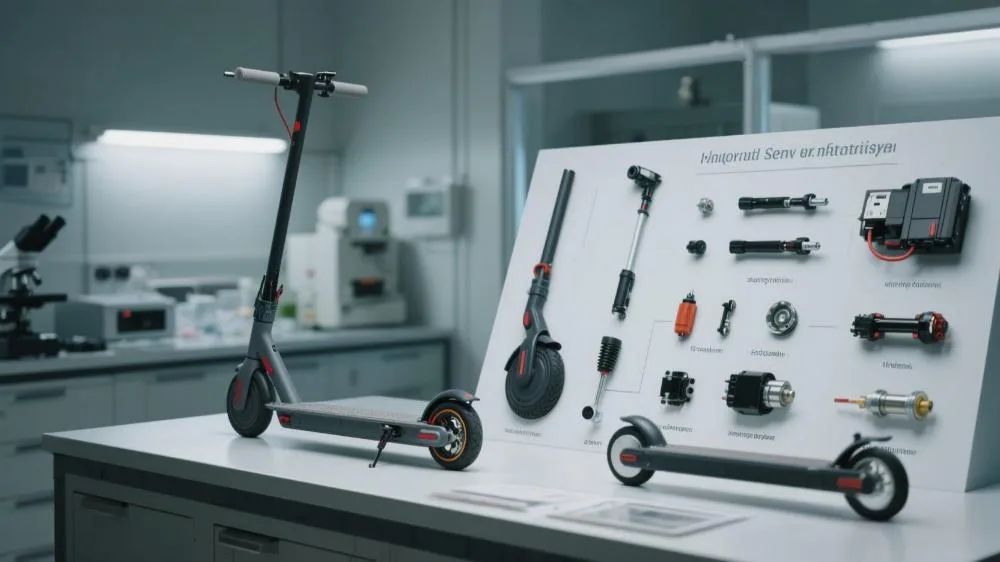how e-scooter works

Electric scooters have become iconic urban mobility solutions across Western cities. According to the European Sustainable Transportation Association’s (ESTA) 2025 report, e-scooter adoption has reached 43% of urban populations – nearly triple 2020 levels. How e-scooter works? Analysis from specialist platform novascooter indicates understanding their mechanics can improve efficiency while reducing malfunction risks by over 35%.
Modern e-scooters comprise five critical systems: powertrain (42% of cost), control unit (23%), energy storage (18%), frame (12%), and auxiliary features (5%). MIT’s 2025 research reveals brushless motor models achieve 92% energy conversion efficiency, significantly outperforming traditional brushed motors (75-80%). This directly translates to extended range and quicker acceleration.

Powertrain Mechanism Explained
Motor Drive System
Brushless DC Motor (BLDC) Operation:
- Controller receives throttle input (0.8-4.2V analog signal)
- Three-phase inverter converts DC to pulsed AC
- Stator windings generate rotating magnetic field (up to 3000rpm)
- Permanent magnet rotor synchronizes (2-12Nm torque output)
Key Performance Metrics:
- Gradeability: 8-10 degrees (standard urban incline)
- Startup current: 15-20A peak (5-8A continuous)
- Regenerative braking recovers 12-15% kinetic energy
Transmission Configurations
Mainstream Solutions:
- Direct drive (72% market share)
- Integrated motor-wheel design
- Zero mechanical loss but heavier
- Geared reduction (23%)
- 3:1 ratio boosts torque
- Requires periodic lubrication
- Belt drive (5%)
- Quiet operation but lower durability
Usage Guidelines:
- Avoid continuous full-load operation beyond 30 minutes
- Monthly axle bearing grease inspection
- Maximum wading depth at axle height
Energy Management Analysis
Lithium Battery Advancements
2025 Battery Standards:
- Cell chemistry: 65% LFP vs 35% NMC
- Voltage platforms: 36V (entry), 48V (mainstream), 52V (performance)
- Capacity range: 7.8Ah-15.6Ah (25-60km range)
Charging Cycle Data:
- LFP: Retains 80% capacity after 2000 cycles
- NMC: Requires replacement after 800 cycles
- Fast charging reduces total lifespan by 15%
Smart Power Monitoring
Battery Management System (BMS) Functions:
- Cell voltage balancing (±0.02V tolerance)
- Temperature monitoring (-20℃ to 55℃ range)
- Precise charge tracking (1mAh resolution)
- Self-diagnosis (16 fault detection modes)
User Interface Logic:
- Open-circuit voltage method (±5% static accuracy)
- Coulomb counting (±2% dynamic accuracy)
- AI range prediction (considers gradient/load)
Control System Technologies
Electronic Speed Controller (ESC)
Signal Processing Chain:
- Hall sensors sample throttle position (100Hz rate)
- MCU calculates PWM duty cycle (10bit resolution)
- MOSFETs regulate motor current (8-16kHz switching)
- Real-time RPM feedback enables closed-loop control
Protection Mechanisms:
- Overcurrent cutoff (<100μs response)
- Stall detection (2-second auto-shutdown)
- Low-voltage disconnect (prevents over-discharge)
Human-Machine Interface
Dashboard Layout:
- Primary data: Speed, battery level, odometer
- Status indicators: Lights, error codes, Bluetooth
- Secondary info: Mode selection, ambient temp
Control Logic:
- Short press: Power/mode toggle
- 3-second hold: Light control
- Button combos: Service mode access
Frame Design and Safety Features
Structural Engineering
Frame Specifications:
- Material: 6061 aluminum alloy (2.5-3mm thickness)
- Load capacity: 120kg static (1.8 safety factor)
- Vibration tested: 100,000 cycles at 3G acceleration
Folding Mechanism:
- Self-locking hinge (>2000N tensile strength)
- Wear-resistant bushings (>5000-fold lifespan)
- Anti-loosening design (<0.3mm vibration displacement)
Active Safety Systems
2025 EU Mandates:
- Auto brake light (>1.5m/s² deceleration trigger)
- 360° reflective strips
- Speed alert (continuous beep above 25km/h)
User-Upgradable Options:
- Turn signals (requires CAN bus support)
- Tire pressure monitoring (TPMS)
- Rear radar (5m detection range)
Troubleshooting and Maintenance
Electrical Diagnostics
Fault Tree Analysis: Symptom → Potential Cause → Verification No power → Circuit breaker tripped → Check battery voltage Intermittent operation → Loose connection → Wiggle test wiring Motor noise → Hall sensor failure → Measure resistance
Multimeter Testing:
- Full charge voltage: 42V(36V)/54.6V(48V)
- Throttle signal: 0.8V(min)-4.2V(max)
- Phase resistance: 0.1-0.3Ω (<5% imbalance)
Mechanical Upkeep
Maintenance Schedule:
- Every 500km: Lubricate bearings/check fasteners
- Quarterly: Brake adjustment/tire rotation
- Annually: Shock oil change/wire harness inspection
Recommended Tools:
- Torque wrench (5-25Nm range)
- Bearing puller (62mm hub compatible)
- Dielectric grease (for connectors)
